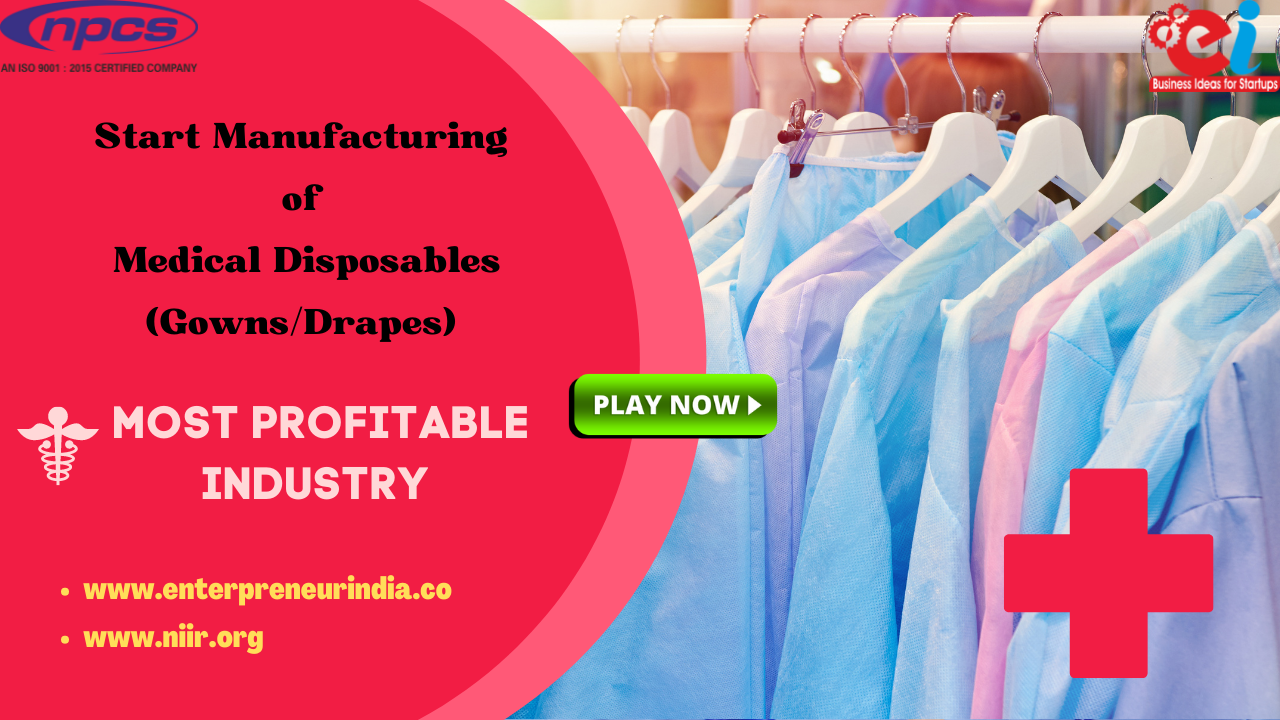
The manufacturing of medical disposables gowns is a booming business segment within the global healthcare industry. With growing demand from hospitals, clinics, laboratories, and home care environments, the market for disposable protective apparel has expanded rapidly in the last few years. These gowns, essential for preventing the spread of infections, saw massive growth during the COVID-19 pandemic and continue to remain vital across medical and surgical applications. Entrepreneurs and investors looking for a scalable, hygiene-focused, and regulation-driven opportunity can benefit immensely from the manufacturing of medical disposables gowns. As awareness about infection control grows, even non-medical sectors like hospitality, cleaning services, and research institutions are driving demand for disposable gowns. Whether catering to domestic needs or exploring exports, this business holds vast potential for those ready to comply with quality standards, certifications, and operational precision.
Related Project: Business of Medical Disposables Gowns and Drapes
Market Demand and Growth Opportunities
The global market for disposable medical gowns is expected to grow significantly due to increasing awareness of healthcare hygiene, rising surgical procedures, and stricter infection control protocols. The manufacturing of medical disposables gowns fits directly into this rising demand curve, particularly as hospitals increasingly prefer single-use apparel to reduce cross-contamination. North America, Europe, and parts of Asia Pacific are dominant consumers, but developing nations in Africa, Southeast Asia, and Latin America are also witnessing fast growth. Large-scale tenders from government healthcare agencies and institutional buyers create long-term contracts for manufacturers. The rise of medical tourism, outpatient surgical procedures, and aging populations adds further fuel to the fire. Disposable gowns are also favored in emergencies and disasters where rapid response and hygiene are key.
Related Feasibility Study Reports: Surgical, Medical Plastics, Medical Disposables, Disposable Medical Products used in Hospitals
Types of Disposable Gowns
Understanding product variation is crucial in the manufacturing of medical disposables gowns. The most common types include isolation gowns, surgical gowns, procedural gowns, and coveralls. Each type has specific use cases and performance requirements. Isolation gowns are used for basic patient care, while surgical gowns are designed to provide barrier protection during operations. Gowns can be sterile or non-sterile depending on their application. Material types also vary—polypropylene (PP), SMS (Spunbond-Meltblown-Spunbond), PE film-laminated fabrics, and even biodegradable materials are popular choices. Manufacturers may also provide customization in sizes, colors, cuff styles, and neck closures. Product line diversity ensures better market penetration and client satisfaction.
Read our Book Here: Handbook on Medical and Surgical Disposable Products
Raw Materials and Machinery
The key raw materials for the manufacturing of medical disposables gowns include nonwoven fabrics like PP, SMS, and SMMS (Spunbond-Meltblown-Meltblown-Spunbond). These materials are chosen for their durability, breathability, and barrier properties. Additional materials may include elastic bands, Velcro, tie tapes, and PE films for fluid-resistant applications. For sterile gowns, sterile packaging material is also essential. The manufacturing process involves cutting, stitching (or ultrasonic welding), and packaging. Machinery used includes automatic cutting machines, sewing machines, ultrasonic sealing machines, and packaging units. High-volume production often requires semi-automated or fully automated lines, especially for meeting bulk hospital or export demands.
Read our Books Here: Disposable Products
Production Process Overview
The manufacturing of medical disposables gowns typically begins with unrolling the nonwoven fabric, cutting the pattern as per standard gown sizes, and stitching or sealing the fabric using ultrasonic welding technology. The sleeves and cuffs are then attached, followed by neckline finishing and waist tie attachment. For high-level surgical gowns, additional layers or coatings may be added to enhance fluid resistance. After assembly, gowns are folded, packed (sterile or non-sterile), labeled, and boxed for shipment. Quality checks are conducted at each stage to ensure tear resistance, seam strength, and adherence to safety standards. Manufacturers supplying to international markets also perform sterilization through EO (ethylene oxide) or gamma radiation, depending on product use and buyer requirements.
Visit this Page for More Information: Start a Business in Medical Disposables Industry
Quality Standards and Certifications
Compliance with health and safety standards is critical in the manufacturing of medical disposables gowns. International buyers typically require certifications such as ISO 13485 (Medical Devices), CE marking (for the European market), FDA registration (USA), and local health ministry approvals. Additionally, gowns are expected to meet AAMI (Association for the Advancement of Medical Instrumentation) levels—ranging from Level 1 to Level 4—based on liquid barrier performance. For export purposes, lab testing, documentation, and audit trails are a must. Ethical sourcing, good manufacturing practices (GMP), and environmental compliance also influence buyer decisions. Aligning with global standards ensures higher pricing, greater trust, and access to premium markets.
Watch Video: Starting a Business of Medical Protective Gowns | Medical Disposables Gowns and Drapes
Cost Structure and Profitability
Initial investment in the manufacturing of medical disposables gowns depends on the production scale, level of automation, and compliance needs. Small-scale units can start with manual or semi-automatic setups for local supply, while medium to large units may invest in advanced machinery and cleanroom environments. Major cost heads include raw materials, machinery, utilities, labor, certifications, and packaging. Profit margins typically range between 20%–35%, depending on order volume, quality level, and brand reputation. Bulk orders from hospitals or healthcare procurement agencies can yield consistent cash flow. Selling under your own brand or white-labeling for medical distributors offers different routes for scaling the business.
Watch other Informative Videos: Surgical, Medical Plastics, Medical Disposables, Disposable Medical Products used in Hospitals
Challenges in the Industry
While the manufacturing of medical disposables gowns offers excellent prospects, it comes with challenges. First, competition is intensifying, especially after the pandemic triggered many new entrants into the sector. Maintaining consistent quality and achieving certifications can be time-consuming and expensive. Procurement of raw materials like SMS or SMMS fabrics may be affected by global supply chain fluctuations. Additionally, pricing pressures from institutional buyers can reduce margins unless you achieve high volumes. For exporters, logistics, compliance, and foreign exchange risks need to be managed. Despite these hurdles, a well-run manufacturing unit with a quality focus and strong marketing can thrive in this space.
Target Markets and Sales Channels
Target customers for the manufacturing of medical disposables gowns include hospitals, nursing homes, diagnostic labs, dental clinics, pharmaceutical companies, government health departments, and NGOs. Sales channels can include direct institutional supply, medical wholesalers, tender-based supply chains, and online platforms. Export markets—especially Africa, Southeast Asia, and Latin America—are growing steadily. Medical trade fairs and healthcare expos are excellent platforms for building B2B relationships. Creating a presence on B2B marketplaces like IndiaMART, Alibaba, or TradeIndia can generate regular inquiries. Private label partnerships with PPE brands or healthcare chains also offer steady volume deals.
Final Thoughts
The manufacturing of medical disposables gowns is more than just a reactive opportunity—it’s a sustainable, future-oriented business aligned with global health priorities. With continuous focus on hygiene, safety, and infection prevention, the demand for disposable gowns is here to stay. Entrepreneurs who understand material science, regulatory frameworks, and production workflows can build a competitive business in this segment. By combining quality control with supply chain efficiency, manufacturers can serve both local hospitals and international markets with confidence. As the healthcare industry evolves, the role of reliable, certified disposable gowns will become even more central—making this manufacturing business one of the most promising ventures in the medical supplies domain.
Read Similar Articles: Medical Disposables
See More Links:
- Start a Business in Asia
- Related Market Research Reports
- Start a Business in Potential Countries for Doing Business
- Best Industry for Doing Business
- Business Ideas with Low, Medium & High Investment
- Looking for Most Demandable Business Ideas for Startups
- Start a Business in Africa
- Start a Business in India
- Start a Business in Middle East
- Related Videos
- Related Books
- Related Projects
NIIR PROJECT CONSULTANCY SERVICES, DELHI
An ISO 9001:2015 Company
ENTREPRENEUR INDIA
106-E, Kamla Nagar, Opp. Mall ST,
New Delhi-110007, India.
Email: npcs.ei@gmail.com
Tel: +91-11-23843955, 23845654, 23845886
Mobile: +91-9097075054, 8800733955
Website: https://www.entrepreneurindia.co
https://www.niir.org





